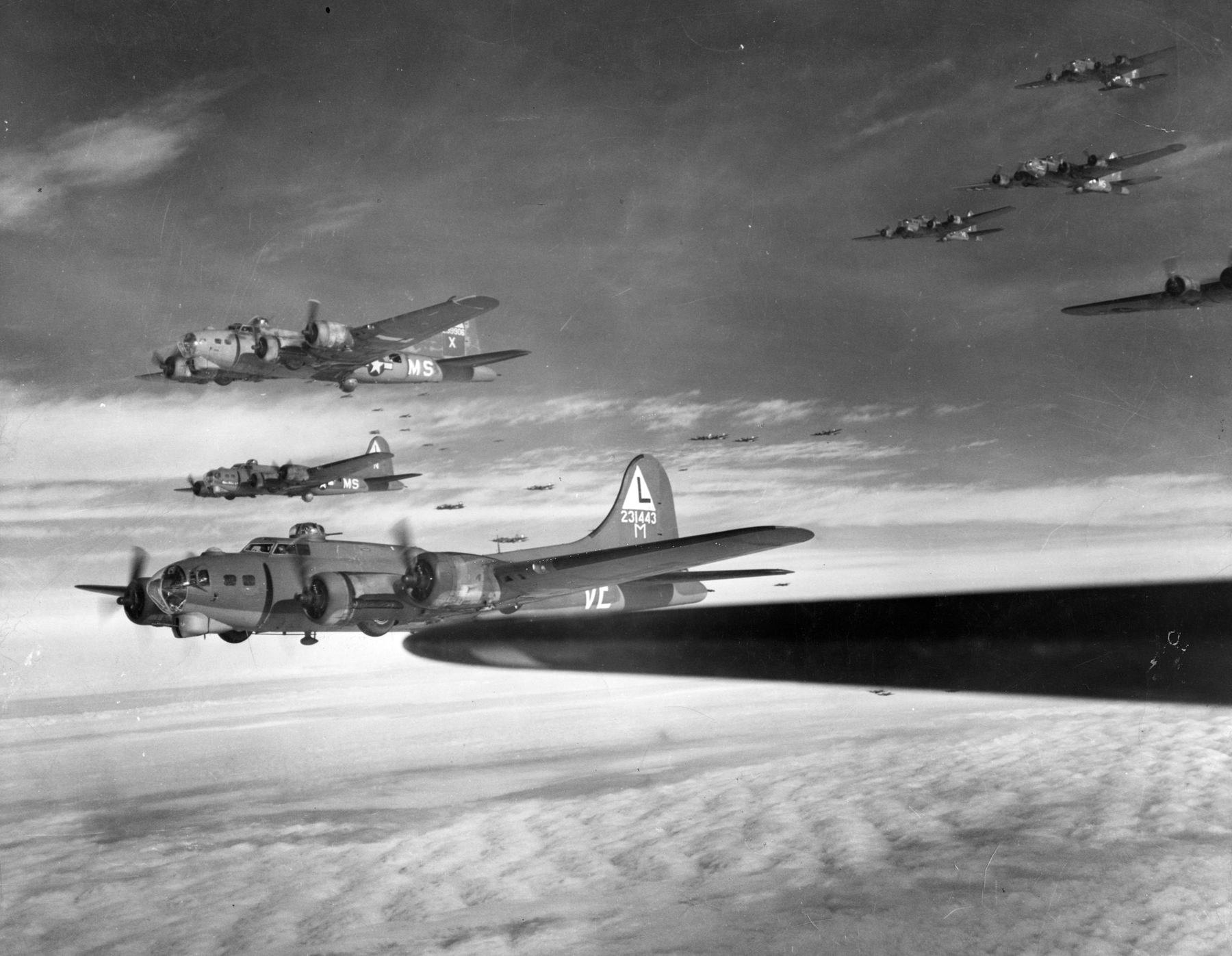
A formation of Eighth Air Force B-17s. US Air Force.
In mid 1944, the US Army Air Force’s strategic bombers began to permanently damage vital parts of the German economy, and hurt the German war effort. Before and after the Normandy landings in early June, 1944, the bombers supported the Allied ground effort in France by attacking railways and German troop concentrations. But alongside this, the bomber men began repeated attacks on fuel and chemical refining, a genuine vulnerability in the German economy, and wrecked Germany’s railroads, canals, and river transportation. Before this, the USAAF defeated the Luftwaffe in the air.

P-51D of the 78th Fighter Group in Europe, 1945. Imperial War Museum.
U.S. fighter pilots began receiving a new type of fighter plane, the P-51, in late 1943. The “Mustang” was an excellent combat machine with amazingly long range. P-51s could escort the bombers to and from their targets anywhere over Germany, and in the hands of trained pilots were the equal or better to most German fighters. And the bomber fleet was growing. US B-17 and B-24 units were organized into two mighty air fleets, the Eighth Air Force based in England, and the Fifteenth Air Force operating from airbases in the Mediterranean basin. By July 1944, RAF Bomber Command and the two U.S. bomber commands in Europe had collectively over 5,000 heavy bombers. Now, raids consisting of 1,000 bombers with fighter escort were possible, unleashing devastating torrents of bombs on cities.
Capitalizing on the P-51, USAAF leaders focused on destroying the German Air Force, not simply with bombs, but also in the air. U.S. bomber crews continued to attack aircraft factories at places such as Braunschweig, Stuttgart, and Regensberg, but this was as much to compel German fighter pilots to come up to altitude and attack the bombers. The Luftwaffe men now faced combat with well-trained American fighter pilots flying P-51s. In the first five months of 1944, the Luftwaffe lost most of their fighter pilots in combat with American bombers and fighters. As experienced pilots were killed, they were replaced by hastily-trained young men who often didn’t last long in subsequent air battles. After allied forces liberated parts of France and Belgium, more allied fighters could reach the air battles in German skies. By late 1944, the weakened Luftwaffe was helpless to stop the massive bomber fleets from pummeling German cities at will, or the advance of allied armies on the ground.
Beginning in May 1944, USAAF bombers, with help from the RAF, repeatedly bombed oil refineries and processing plants at Leuna, Ludwigshafen, Zwickau, Zeitz, Chemnitz, and other locations in the Oil Campaign. The allies had occasionally attacked these targets before, but they hadn’t concentrated specifically on that industry. Between May 1944 and May 1945, the allies dropped over 185,000 tons of bombs on these plants.
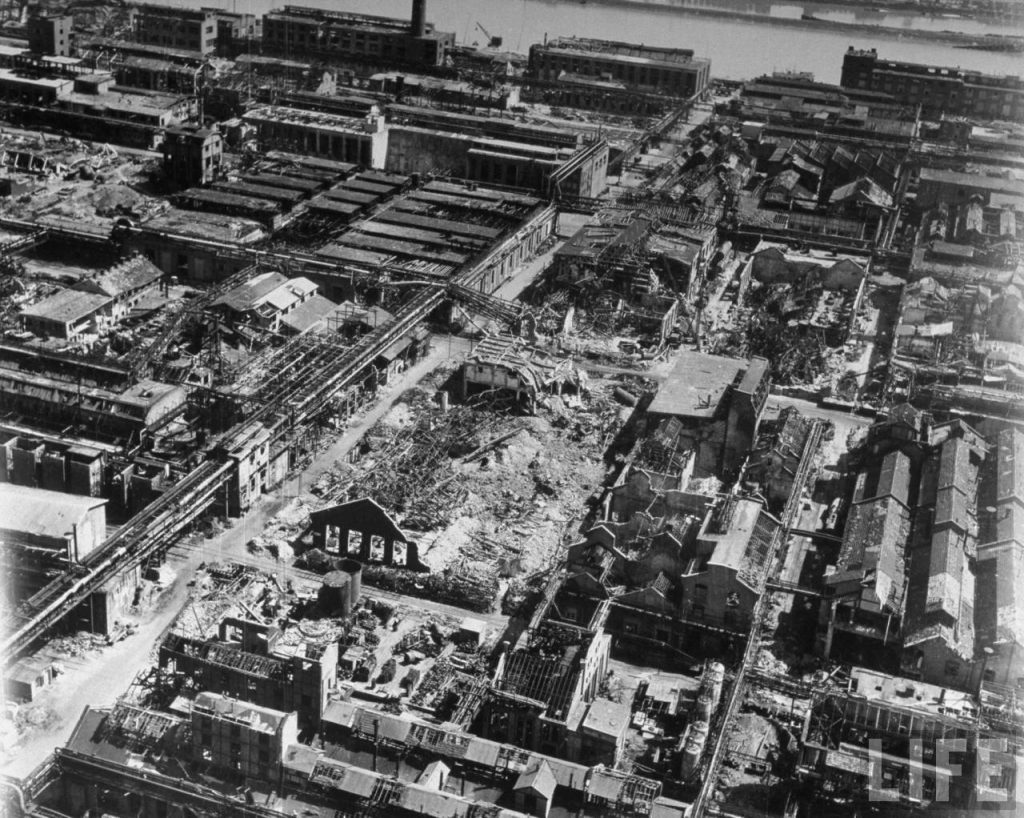
Smashed chemical works of the I.G. Farben company, Ludwigshafen, 1945. Margaret Bourke-White, Life Magazine, 1945.
Fuel and chemical works were especially vulnerable targets. Germany had only a few large plants that supplied much of their fuels and many vital chemicals, a dangerous concentration that worried German leaders even before the Allies focused their efforts on the industry. Certain production processes were difficult to disperse in smaller plants. By the end of the summer, production of fuels, lubricants, and other vital chemicals was dramatically lower than early 1944 levels. Germany lost control of Romanian oil fields in August, and now that fuel production was badly damaged, Germany’s production of fuels dropped sharply.
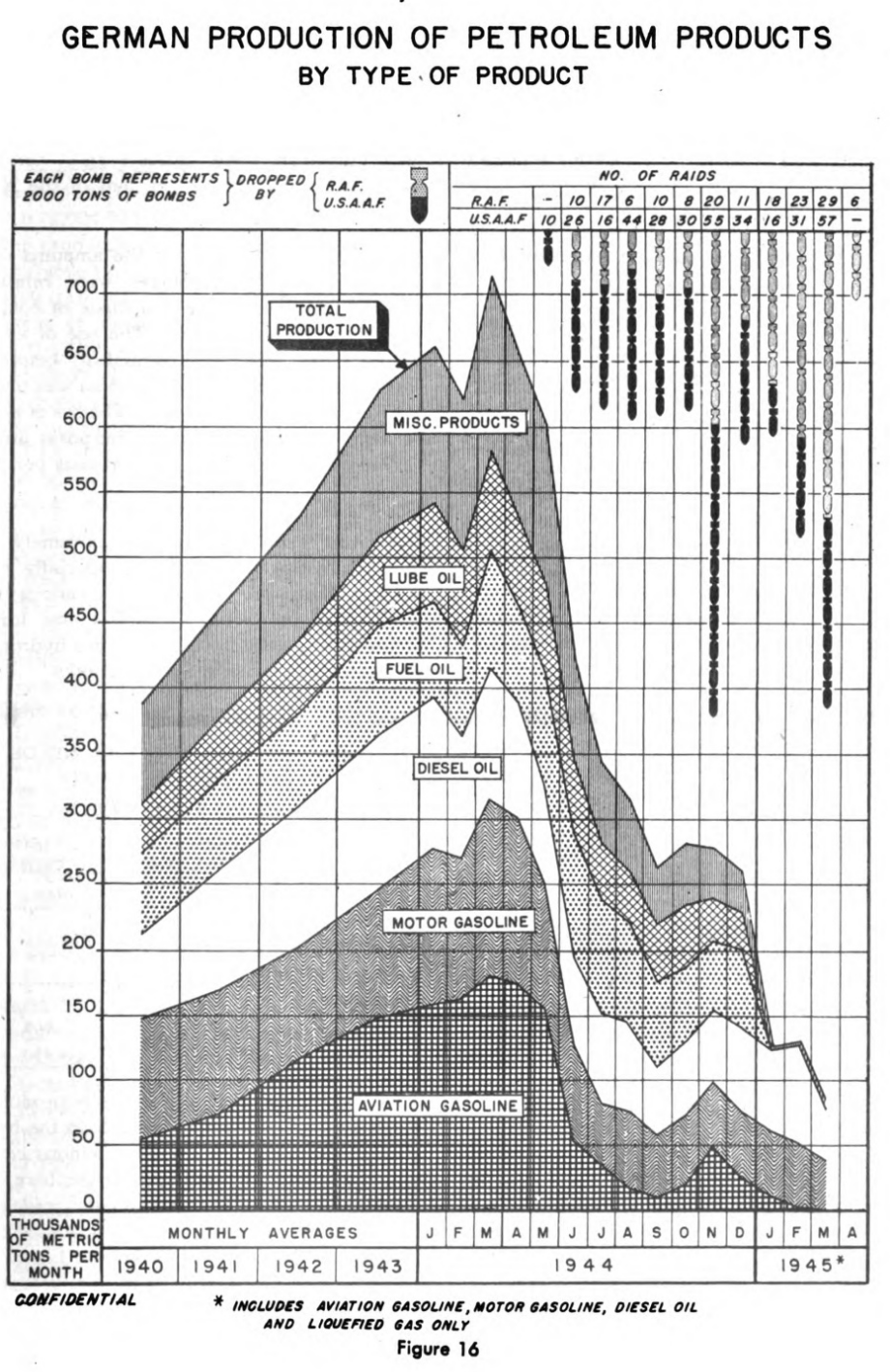
Germany’s fuel and lubricant supplies dropped sharply as the USAAF and RAF stepped up bombing attacks on these plants. Oil Division Report, 1947.
Fuel shortages undermined the German war effort. The Luftwaffe, already hard pressed to replace lost pilots, had to cut back on training for replacements, which doomed new airmen who were unprepared to do battle against the well-trained U.S. fighter pilots. “We were virtually drowning in aircraft,” Luftwaffe veteran and fighter ace Johannes Steinhoff later remembered, “…However, the fuel situation was hopeless; for training purposes almost no fuel was released any more.” Poorly-prepared replacement pilots were easy prey for seasoned U.S. fighter pilots. Steinhoff lamented that by late 1944 “the average young pilot flew only two missions before he was killed.” Badly injured himself, Steinhoff was lucky to survive the war. In late 1944, German generals hoarded fuel for a final counterattack in the west (The Ardennes offensive), but by the end of the year, Germany had lost 2/3rds of its oil-based production. By January 1945, Nazi troops had abandoned thousands of armored vehicles for lack of gas. Other industries at home that depended on liquid fuel and chemicals were similarly stalled.
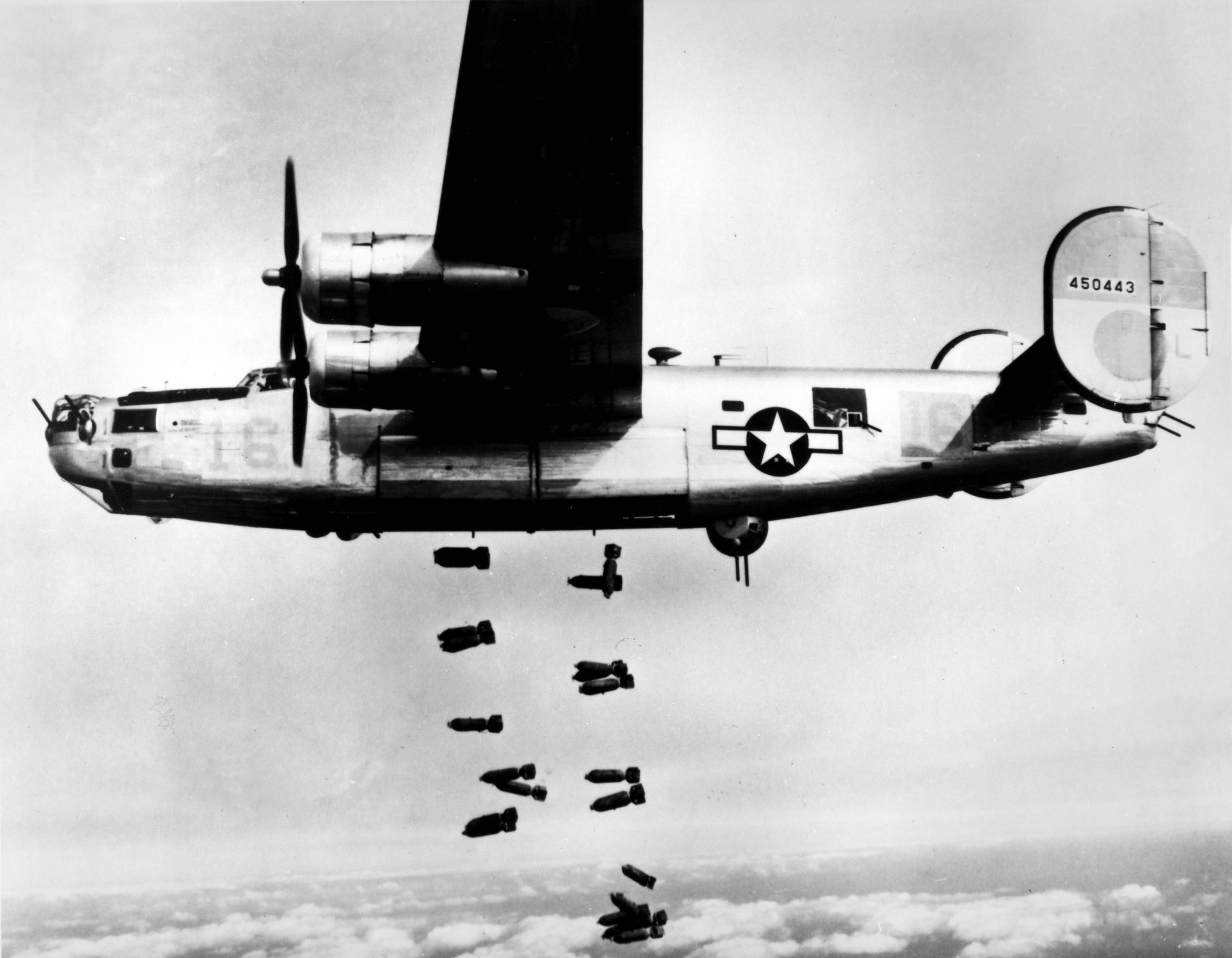
March 1945: a B-24 of the 451st Bombardment Group strikes the railroad yards at Muhldorf, Germany. US Air Force Photo.
The combined bomber offensive also focused on transportation targets, bombing marshaling yards (vast fields of tracks essential for assembling and routing trains), junctions, stations, and repair shops. Allied fighters also attacked moving trains, causing ruinous derailments, and sank barges in canals and rivers. Between September and December 1944, Reichsbahn (German railway) traffic dropped by half. Heavy raw materials, chiefly coal used for power, could not be distributed. German industry lacked electricity to run plants, and materials to supply manufacturing.
Allied air commanders now focused on oil and transportation targets relentlessly. Clearly, the Germans could bring damaged plants back up to production within several weeks. But after mid-1944, oil and transportation targets were bombed repeatedly and regularly. One example, the Deurag-Nerag oil refinery at Misburg, was bombed five times between June and December 1944, and five more times in 1945. Engineers might restart production at a plant to some extent after each raid, but repeated attacks dropped production to lower and lower levels. Railroads were easier to repair, but after summer 1944 German authorities failed to make repairs fast enough. After the 1943 raid on the bearing works at Schweinfurt some engineers wondered why the allies didn’t keep attacking that target. Now, with oil, fuel, and transportation, the USAAF sustained their efforts against a few industries and their targets.
By late 1944, allied ground forces were entering Germany. Soviet, U.S., British, and other allied troops still encountered pockets of strong resistance from German forces, but the German economy was crippled by a lack of fuel and few ways to transport war materials or troops. The bombers had finally made a decisive difference, and viewing the situation in retrospect, it seemed Nazi Germany was doomed.
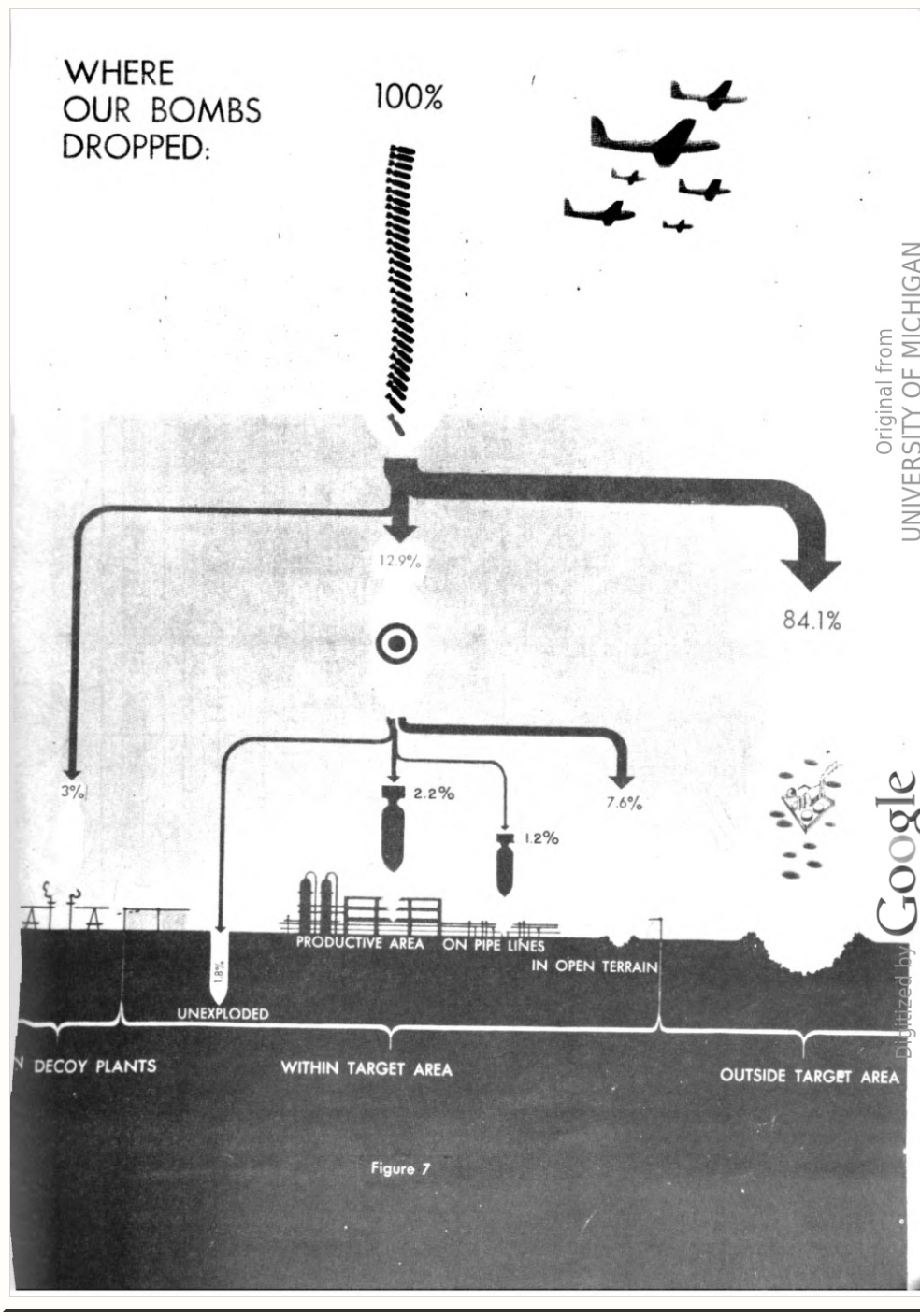
This chart from a postwar study of strategic bombing effectiveness tells a grim story: most bombs dropped on several big fuel plants missed the plant altogether. Oil Division Report, 1946.
The Eighth and Fifteenth Air Forces were still officially committed to precision bombing, but real bombing accuracy was never as precise as the pre-war USAAF had anticipated. The winter months frequently brought cloudy conditions, and most attacks were aimed by radar, which was less accurate than using the Norden sight. In raids on three big fuel and chemical plants at Leuna, Ludwigshaven, and Zeitz, US and British bombers put roughly one out of four bombs within the plant fences when they could see the target through their bombsights. Accuracy dropped still further when bombing at night or with radar. Less than 4% of all bombs dropped struck vital equipment within the plants. 85% of all bombs dropped in attacks on these plants missed altogether. Even when U.S. crews aimed for industrial sites, most of their bombs scattered in a wide pattern in surrounding areas. Giant formations targeting railroad stations, marshaling yards, and junctions also heaped destruction on adjacent neighborhoods, adding to the ruin and fires left by the RAF. High explosive bombs were most useful for attacks against industrial and railroad targets, which were basically concrete and steel. But U.S. planes also carried incendiary bombs, effective in starting fires in housing and commercial structures.
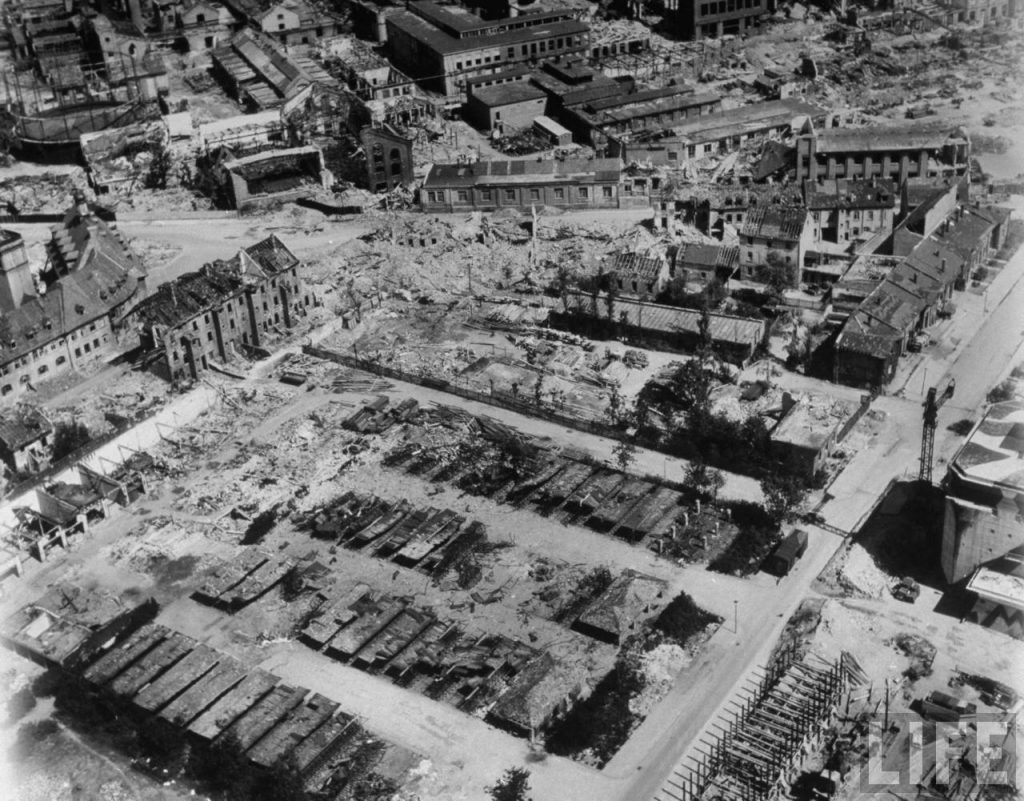
The I.G. Farben chemical plant at Ludgwigshafen was a major target of the Oil Campaign. Surrounding neighborhoods were also pounded by falling bombs.
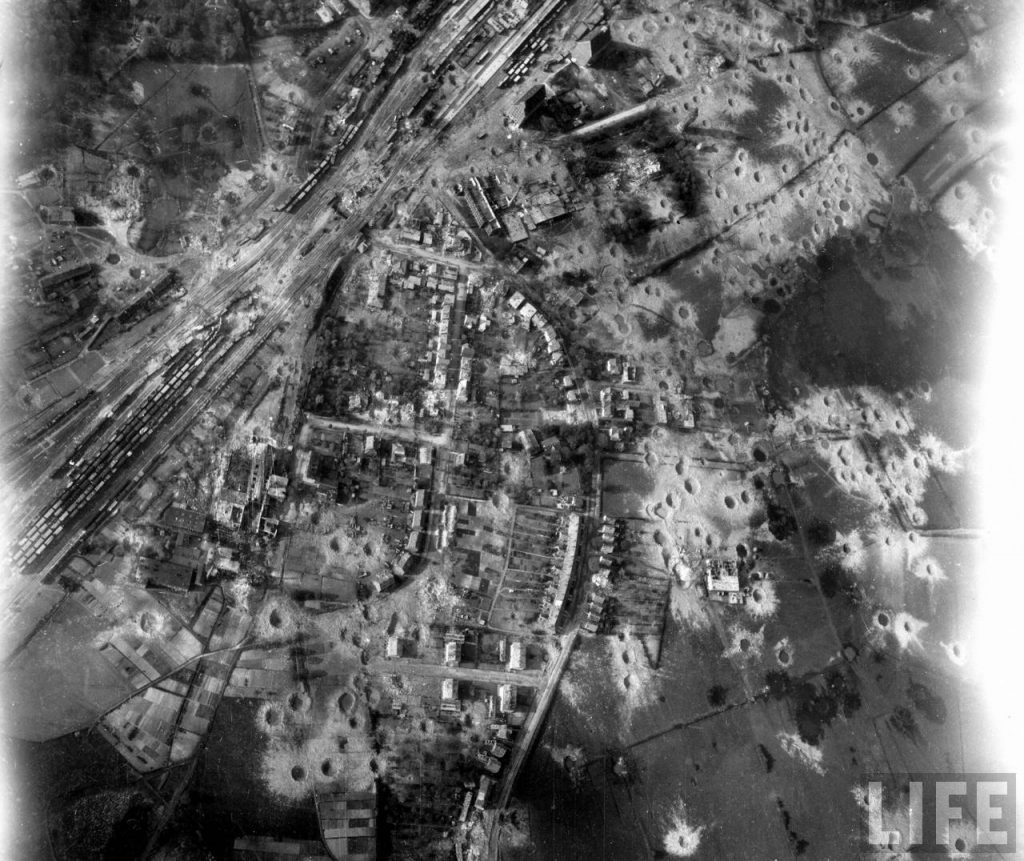
In late 1944, allied airpower wrecked the Reich’s railroads. Houses and shops surrounding this railroad junction in Lübeck were badly hit, too. Margaret Bourke-White, Life Magazine, 1945.
Until the end, the USAAF never officially abandoned the doctrine of precision bombing. At least for a time, USAAF commanders resisted what one officer called a “baby-killing” tactics. In Mid-1944, Army Air Force General Carl Spaatz believed that RAF’s Bomber Command would face widespread criticism after the war for its tactics of dumping bombs indiscriminately on German civilian centers. Spaatz wanted to keep U.S. motives, at least, clean by comparison. Generals Jimmy Doolittle and Ira Eaker, commanding the Eighth and Fifteenth Air Forces respectively, protested as their leaders in the United States insisted that bomber forces attack German cities with the goal of causing massive civilian casualties or social breakdown. However humane, this moral position by USAAF generals seemed out of tune with what the B-17s and B-24s were actually doing to German cities.

This famous image was captured by Richard Peter from the top of the town hall weeks after the raid on Dresden. The firestorm burned away all that was flammable, leaving stone or concrete shells of buildings standing amidst the rubble. Deutsche Fotothek.
In February and March 1945, the Eighth Air Force launched massive raids on Berlin that attacked the city center, rather than any particular industrial targets. Ostensibly the bombers targeted train stations, but the city was crowded with refugees fleeing the advancing Soviet Army to the east. Allied leaders suspected that the raids would create general chaos in the already-battered Nazi capital, making it difficult for Nazi officials to maintain control and move troops in the region efficiently. Thousands of Germans were killed in these attacks.
In February 1945, British and American bombers attacked Dresden, a city in southeastern Germany. Dresden had little that was obviously important for the German war effort. Again, Allied commanders reasoned that German forces would need the city’s railyard and train stations to move troops into the area to stop the Soviet Army, which was only 25 miles east of the city. Both the RAF and USAAF launched attacks on the city. The bombs, falling on a city crowded with refugees, started massive fires that killed 25,000 people, including allied prisoners of war. While RAF bombers might have inflicted more deaths and destruction on Dresden, USAAF aircraft certainly added to the slaughter.
In early May, after most of Germany were occupied by allied ground forces, Hitler and other Nazi leaders committed suicide. Soon afterwards, the remnants of the German government surrendered.
